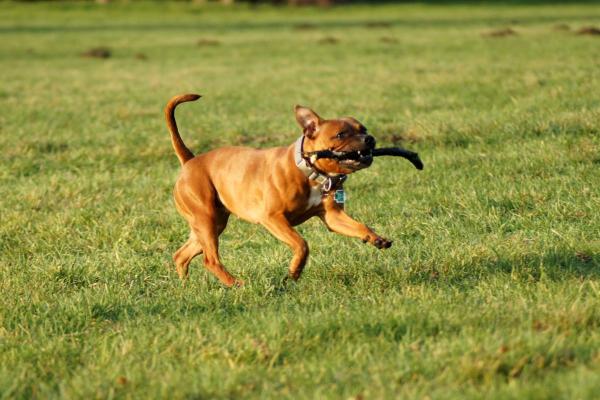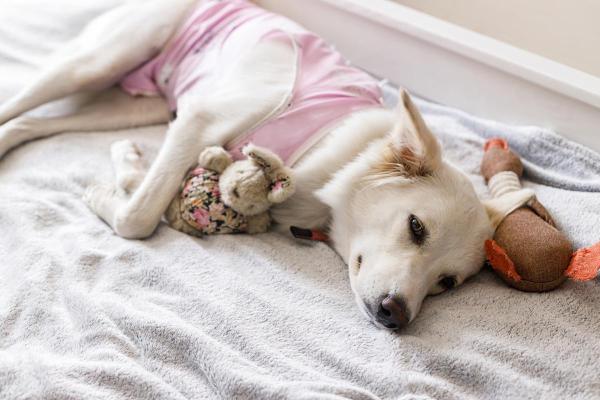
Running, jumping and playing are activities young dogs need as much as they enjoy. They help to maintain a healthy physical development, as well as reinforce cognitive skills. Play is also a very important tool for socialization. Through play activity, the dog learns boundaries when interacting with others, as well as how to feel secure in a variety of environments. Young dogs also develop sexually, something which can be problematic in the domestic environment. For this reason, veterinarians recommend spay surgery to neuter them. This involves surgical removal of the reproductive organs which can take time to heal, prompting us to ask how long after a spay can a dog play?
Generally speaking, a dog needs around 10-14 days to be able to start playing after spay surgery. This allows the wound time to heal and to minimize the possibility of complications such as the stitches coming out or secondary bacterial infection. AnimalWised explains what you need to consider with a dog's recovery time for exercise.
How long does it take for a spayed dog to recover?
Neutering female dogs is a procedure which is recommended by veterinarians for almost all dogs. In fact, it is a legal requirement in many countries, unless their guardian has a license for breeding. Neutering is a permanent form of sterilization, meaning the animal cannot become pregnant. However, there are different ways to affect a dog's fertility:
- Sterilization: this is the general term for stopping a dog from being fertile. It can be permanent or temporary. Temporary sterilization can be carried out using drugs.
- Spaying: the term ‘spay’ is a term for neutering in female dogs and requires removal of the reproductive organs. It most commonly refers to an ovariohysterectomy which is the removal of both the uterus and ovaries. An ovariectomy removes only the ovaries, but this is less common.
The reason for removing all of the reproductive organs is not simply to better ensure the dog does not become pregnant. She cannot do so without ovaries, even if the uterus remains. The reason is that these reproductive organs produce sex hormones which can affect the dog's behavior. They can also influence the development of various reproductive diseases such as fatal uterine cancers.
Despite requiring a surgical incision, spaying is a relatively simple procedure. It is minimally invasive and the risk of harm is very low. It is considered a routine veterinary procedure. The postoperative period is short, but it will depend on the nature of the intervention. Some spay surgeries use smaller incisions and internal sutures, promoting a faster recovery time.
Discover more about complications after ovariohysterectomy with our article asking can spayed dogs get pyometra?
Postoperative care of a spayed dog
Although it is a routine procedure, we still need to be careful with a dog during the recovery period. Initial care after the spay usually requires medication such as preventive antibiotics and painkillers. The use of pain medication may stop after 24 hours, but some dogs may need more administered if they are showing signs of pain.
It is particularly important that we prevent the dog from accessing the incision. This will prevent the removal of stitches and the promotion of proper wound healing. It also prevents bacteria entering the wound. This can cause a secondary infection which can be dangerous.
E-collars can prevent them licking, biting or scratching the area, but a surgery recovery suit can also protect it from their environment. This stops them from bumping into objects, trailing their abdomen on the ground or contorting their body too much. These activities can cause the stitches to fall out, a risk which is exacerbated by play or exercise.
There is no fixed recovery time for dogs. Some dogs may be quite listless after they recover from anesthesia, but others will be active again within hours. Spay incision healing time varies depending on the type of procedure and the individual dog. Generally speaking, stitches are removed after 7-10 days, but some procedures use stitches which naturally absorb back into the dog's body.
During the spay wound healing process, we need to limit their activity to prevent the stitches coming out or other complications. This can be difficult depending on the energy levels of each dog.

How long after spaying can a dog play?
A dog's play drive will be low immediately after surgery as they recover from anesthesia. Their abdomen will be tender and potentially painful since spaying requires an incision in the skin. Some dogs may recover their play drive within hours of the spay surgery. While it is good to see the dog is feeling healthy, we need to limit their play.
An open incision carries risks, which can range from a simple delay in healing due to a second closure to the need for further anesthesia and suturing. Although rare, a complete opening of the incision could lead to the release of the contents of the abdominal cavity. This is a veterinary emergency.
To prevent complications and promote healing, it is important to wait at least a week after surgery to carry out activities such as running or jumping. Strenuous exercise should be limited. This is not only to protect the incision, but also because the dog is still in recovery. With this in mind, a dog should be able to play as normal 10-14 days after they are spayed.

What should I do if my spayed dog wants to play?
It is only natural that a spayed dog will want to play once they return to feeling well. Especially since spaying is most common in younger dogs which have a greater play drive. She will ask to play with toys, be chased around the garden or simply gambol around a park. Depending on their level of socialization, they will also want to interact with other dogs in the form of playing games. Some of these games can be rough.
Explaining to a dog that they cannot play is not easy. She won't necessarily be able to understand why you are suppressing her canine nature, something which can be harmful for dogs in the long term. While this will only be a temporary situation, it is our responsibility to help promote proper recovery and avoid complications. To do so, we can look for options which meet her needs without jeopardizing her recovery:
- Longer walks: a newly spayed dog should not run for at least a week, but we should take them for gentle walks to promote recovery. Always do so on a leash to avoid intense or abrupt activity that she can't yet perform.
- Various toys: although we need to limit play, this does not mean we should stop play altogether. There are intelligence games and toys for cognitive development which can be used. They will help satisfy the play drive without risking harm to the spay incision.
- Scent games: especially for dogs whose sense of smell is very important, scent or tracking games can be useful. This involves hiding an object or person and encouraging her to find it using her nose. You can leave clues along the way to encourage her.
Ultimately, it's about directing the dog's energy toward other activities which limit her movement. We also need to provide lots of affection to help her feel secure during this period.
Take a look at our article on the warning signs after spaying a dog to know what to look out for.

If you want to read similar articles to How Long After Spaying Can a Dog Play?, we recommend you visit our Basic care category.